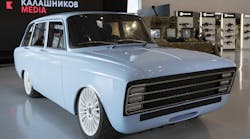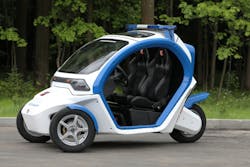Kalashnikov's CV-1 Electric Car: Russia's Answer to Tesla?
The Russian arms maker Kalashnikov, best known for its AK-47 assault rifle, last week unveiled a retro-looking light blue prototype electric car dubbed the CV-1 (Shown above) at the Army 2018 International Military and Technical Forum at Patriot Expo Center outside of Moscow.
Design of the CV-1 is said to be inspired by a Soviet-era hatchback model IZh 2125 “Kombi” developed in the 1970s , which itself resembled a vintage Italian Fiat 124, the model used as the reference design to create Russia's Lada.
According the holding company Kalashnikov Concern, the car has a range of 350 kilometers (217 miles) between battery pack recharges and can accelerate from 0-100 kilometers per hour (62 miles per hour) in six seconds.
While engineers generally know better than to make sweeping generalizations and engage in hyperbole, the same does not necessarily apply to press relations departments. To wit: “This technology will let us stand in the ranks of global electric car producers such as Tesla and be their competitor,” said news agency RIA-Novosti, quoting Kalashnikov's press office. Kalashnikov further said it has developed some cutting-edge elements for its "electric supercar", including a "revolutionary" inverter. No further details on the inverter were provided.
In addition to making weapons Kalashnikov has built electric motorcycles and the electric "Ovum" vehicles that were used at the World Cup in Russia this summer. The Ovum EV has a modular design and the ability to vary the number of passenger seats depending on the requirements of various services of the city. The product is completely built using domestic components. The electric car is characterized by its maker as “smooth running and (with) a low fire and explosion hazard in the event of an accident.”
Kalashnikov’s Ovum EV was used by Moscow police during the World Cup in Russia.
The Pulsar electric motorcycle employs a brushless electric DC motor sourced from the Chinese company Golden Motor with a maximum 30-minute capacity of 15 kW (about 20 hp). Three types of batteries are utilized: lithium-ion, lithium-polymer and lithium-ferrophosphate. The main battery is located above the motor itself. Without recharging the motorcycle is said to be able to travel over 150km and at speeds of up to 100 km/hr.


